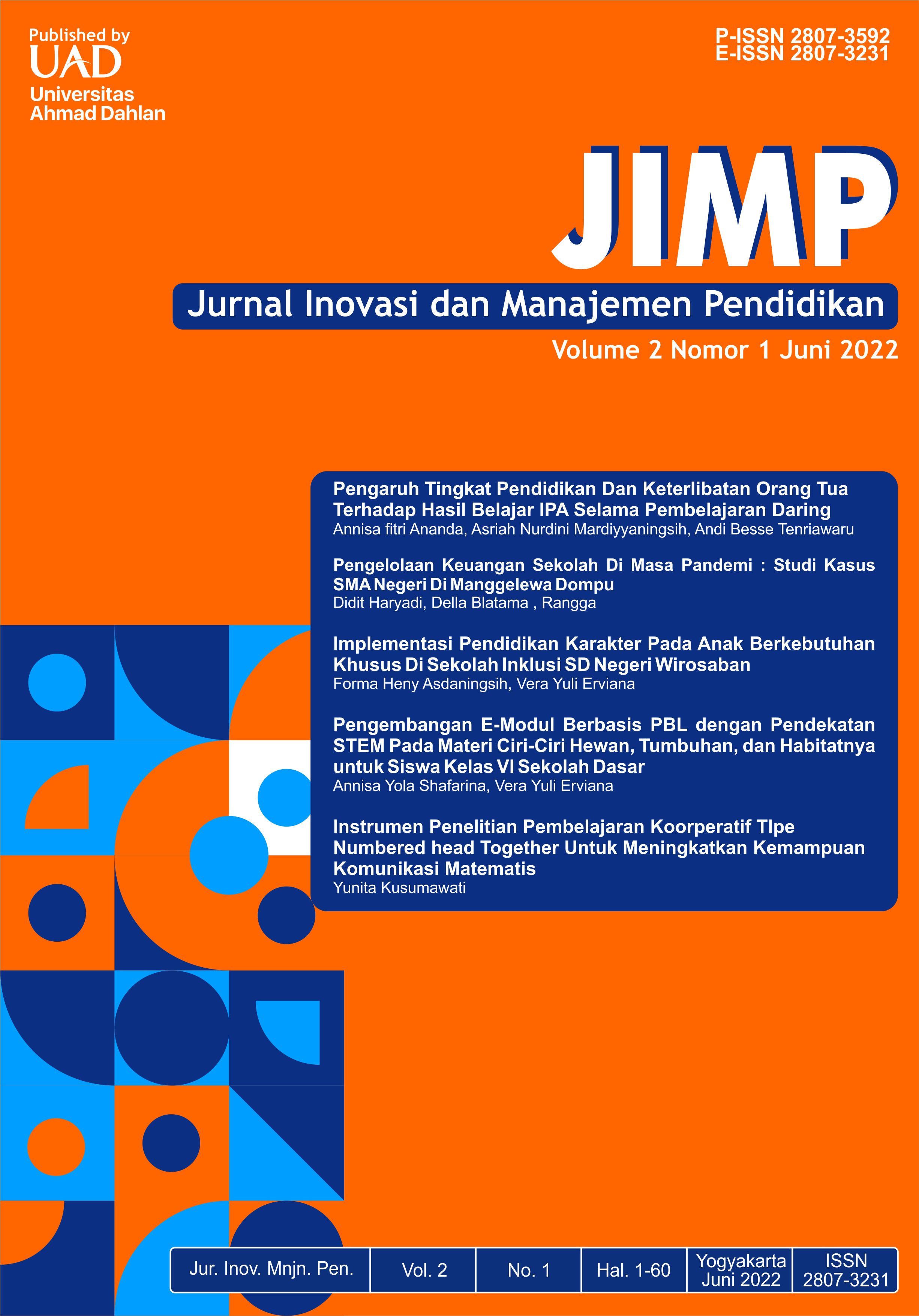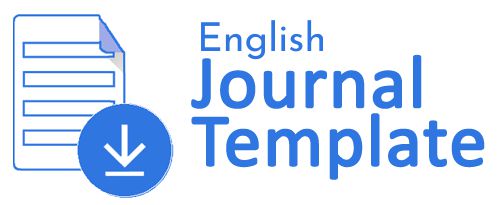Instrumen Penelitian Pembelajaran Kooperatif Tipe Numbered Head Together Untuk Meningkatkan Kemampuan Komunikasi Matematis Siswa SMP
DOI:
https://doi.org/10.12928/jimp.v2i1.4620Keywords:
Matematika, Pembelajaran Kooperatif Tipe Numbered Head Together, Komunikasi MatematisAbstract
Penelitian ini bertujuan untuk mengetahui tentang instrumen penelitian dalam pembelajaran kooperatif tipe Numbered Head Together untuk meningkatkan kemampuan komunikasi matematis siswa SMP di Banten. Metode penelitian yang digunakan adalah survei. Populasi penelitian ini adalah beberapa siswa di Banten, Sampel diambil dengan teknik simple random sampling, sebanyak 36 orang siswa. Instrumen yang digunakan adalah instrumen Numbered Head Together dan  kemampuan komunikasi matematika siswa. Data dianalisis dengan teknik korelasi regresi. Hasil pengujian hipotesis menunjukkan bahwa terdapat pengaruh positif dan signifikan pembelajaran kooperatif tipe Numbered Head Together terhadap kemampuan komunikasi matematika.
References
[2] Astuti, A., & Leonard, L. (2015). Peran Kemampuan Komunikasi Matematika Terhadap Prestasi Belajar Matematika Siswa. Formatif: Jurnal Ilmiah Pendidikan MIPA, 2(2)
[3] Dewi, R. (2017). Pengembangan Instrumen Tes untuk Mengukur Kemampuan Komunikasi Matematis Siswa SMP Negeri 17 Makassar (Doctoral dissertation, Universitas Islam Negeri Makassar).
[4] Fitrianna, A. Y., & Anita, I. W. (2017). Pengembangan LKS Berbasis Assessment for Learning (AFL) Teman Sejawat untuk Kemampuan Matematis Siswa SMP. JURNAL e-DuMath, 3(2).
[5] Hamdi, A. S., & Bahruddin, E. (2015). Metode penelitian kuantitatif aplikasi dalam pendidikan. Deepublish.Diakses dari: https://books.google.co.id/books?id=nhwaCgAAQBAJ&lpg=PR6&ots=FEY3Zic8Au&dq=Dalam%20penelitian%20ini%20penulis%20menggunakan%20pendekatan%20kuantitatif.%20Sementara%20metode%20yang%20digunakan%20adalh%20metode%20survei&lr&hl=id&pg=PR5#v=onepage&q=survei&f=false
[6] Kurnia, R. N., Setiawani, S., & Kristiana, A. I. (2015). Analisis kemampuan komunikasi matematis siswa kelas vii c smp negeri 1 rogojampi tahun pelajaran 2014/2015. ARTIKEL ILMIAH MAHASISWA, I (1): 1-6
[7] Mahmudi, A. (2006). Pengembangan kemampuan komunikasi matematika siswa melalui pembelajaran matematika. Yogyakarta: UNY.\
[8] Pratiwi. R. (2010). Penerapan Pembelajaran Kooperatif Tipe Numbered Head Together (Nht) Untuk Meningkatkan KemampuanKomunikasi Matematika Peserta DidikKelas Viii Smpn 2 TambangKabupaten Kampar (Skripsi, Universitas Islam Negeri Sultan Syarif Kasim Riau, 2010). Diakses dari: http://repository.uin-suska.ac.id/998/
[9] Pratiwi. R. (2010). Penerapan Pembelajaran Kooperatif Tipe Numbered Head Together (Nht) Untuk Meningkatkan KemampuanKomunikasi Matematika Peserta DidikKelas Viii Smpn 2 TambangKabupaten Kampar (Skripsi, Universitas Islam Negeri Sultan Syarif Kasim Riau, 2010). Diakses dari: http://repository.uin-suska.ac.id/998/
[10] Sugiyono, (2009). Metode Penelitian Kuantitatif, Kualitatif Dan R&D. Bandung : Alfabeta
[11] Syaban, M. (2008). Menumbuh kembangkan daya matematis siswa. Educare. Diakses dari:http://educare.efkipunla.net/index.php?option=com_content&task=view&id=62&
Downloads
Published
How to Cite
Issue
Section
License
Copyright (c) 2022 Yunita Kusumawati

This work is licensed under a Creative Commons Attribution-ShareAlike 4.0 International License.
This article's copyright is transferred to Universitas Ahmad Dahlan (UAD) if and when the item is accepted for publication. The undersigned hereby transfers any rights in and to the paper including without limitation all copyrights to UAD. The undersigned hereby represents and warrants that the article is original and that he/she is the author of the paper, except for material identified as to its source, with permission notices from the copyright owners where required. The undersigned represents that he/she has the power and authority to make and execute this assignment.
We declare that:
This paper has not been published in the same form elsewhere.
It will not be submitted anywhere else for publication before acceptance/rejection by this Journal.
Copyright permission is obtained for materials published elsewhere and which require this permission for reproduction.
Furthermore, I/We hereby transfer the unlimited rights of publication of the above-mentioned paper in whole to UAD. The copyright transfer covers the exclusive right to reproduce and distribute the article, including reprints, translations, photographic reproductions, microform, electronic form (offline, online), or any other reproductions of similar nature.
The corresponding author signs for and accepts responsibility for releasing this material on behalf of any co-authors. This agreement is to be signed by at least one of the authors who have obtained the co-author(s) assent where applicable. After submission of this agreement signed by the corresponding author, changes of authorship or in the order of the authors listed will not be accepted.
Retained Rights/Terms and Conditions
Authors retain all proprietary rights in any process, procedure, or article of manufacture described in the Work.
Authors may reproduce or authorize others to reproduce the Work or derivative works for the author's personal use or company use, provided that the source and the UAD copyright notice are indicated, the copies are not used in any way that implies UAD endorsement of a product or service of any employer, and the documents themselves are not offered for sale.
Although authors are permitted to re-use all or portions of the Work in other works, this does not include granting third-party requests for reprinting, republishing, or different types of re-use.







